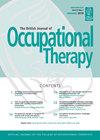Interventions to improve the occupational performance of people with post stroke with upper limb apraxia – A systematic review and meta-analysis
IF 1.3
4区 医学
Q3 REHABILITATION
引用次数: 0
Abstract
Introduction: Upper limb apraxia is a post stroke disorder affecting the persons’ ability to perform everyday activities. This review aimed to determine the effectiveness of interventions on occupational performance outcomes. Method: A systematic review of literature (2000-2022) across five electronic databases was conducted. PRISMA guidelines were applied. Data were pooled using RevMan. Findings: Four studies reporting findings from three randomised controlled trials were included. The methodological quality of studies was low. Three treatment approaches were reported: (1) strategy training (2) gesture training (3) combined gesture and strategy training. Strategy training alone or in combination with gesture training was significantly more effective than control interventions in improving occupational performance scores (FEM, mean difference: 1.08, 95% confidence interval: −6.01–8.16, I2 = 0%). Conclusion: This review provides low quality evidence to support the use of strategy training alone, or in combination with gesture training, by Occupational Therapists to improve occupational performance and apraxia scores post intervention among people with post stroke upper limb apraxia.改善中风后上肢瘫痪者职业表现的干预措施--系统回顾和荟萃分析
简介上肢瘫痪是一种中风后障碍,影响患者进行日常活动的能力。本综述旨在确定干预措施对职业表现结果的有效性。研究方法对五个电子数据库中的文献(2000-2022 年)进行了系统性回顾。采用了 PRISMA 指南。使用 RevMan 对数据进行汇总。研究结果四项研究报告了三项随机对照试验的结果。研究的方法学质量较低。报告了三种治疗方法:(1) 策略训练 (2) 手势训练 (3) 手势和策略联合训练。在提高职业表现评分方面,单独进行策略训练或结合手势训练的效果明显优于对照干预(FEM,平均差异:1.08,95% 置信区间:-6.01-8.16,I2 = 0%)。结论本综述提供了低质量的证据,支持职业治疗师单独使用策略训练或结合手势训练来改善中风后上肢障碍患者的职业表现和干预后的障碍评分。
本文章由计算机程序翻译,如有差异,请以英文原文为准。
求助全文
约1分钟内获得全文
求助全文
来源期刊

British Journal of Occupational Therapy
REHABILITATION-
CiteScore
2.20
自引率
15.40%
发文量
81
审稿时长
6-12 weeks
期刊介绍:
British Journal of Occupational Therapy (BJOT) is the official journal of the Royal College of Occupational Therapists. Its purpose is to publish articles with international relevance that advance knowledge in research, practice, education, and management in occupational therapy. It is a monthly peer reviewed publication that disseminates evidence on the effectiveness, benefit, and value of occupational therapy so that occupational therapists, service users, and key stakeholders can make informed decisions. BJOT publishes research articles, reviews, practice analyses, opinion pieces, editorials, letters to the editor and book reviews. It also regularly publishes special issues on topics relevant to occupational therapy.
 求助内容:
求助内容: 应助结果提醒方式:
应助结果提醒方式:


